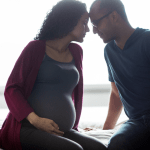What is pubic synthesis dysfunction and how do I know if I have it or I’m at risk for it?
Pubic synthesis dysfunction is when your ligaments that normally keep your pelvic bone aligned during one’s pregnancy become too relaxed and stretchy after childbirth. This causes the pelvic joint or the pubic synthesis to become unstable and which in turn causes pelvic pain.

Some symptoms include difficulty while walking and pain in your pelvis, typically focused in the pubic bone area, and can also radiate toward the upper thighs and perineum. This doesn’t only happen while walking, but it can happen when you’re lifting heavy items, climbing the stairs, getting dressed, even getting into your car, and sometimes while you’re just in bed.
What can you do to help? There are many things you can do to ease your discomfort. First, awareness is key to prevention. Be careful with your movement in pregnancy and postpartum. During child birth, the hormone relaxin is released in large quantities by the placenta in order to loosen the ligaments in the pelvis, which in turn softens and widens the cervix to facilitate child being born. The main function of the relaxin hormone is to relax the pubic synthesis. Your body may start producing this hormone as early as ten weeks into your pregnancy.
Secondly, we recommend hip stabilization exercises pre pregnancy and during pregnancy and also using an SI lock belt. This is also known as SI lock or sacroiliac belt support and this helps to compress the SI joint and give support to the pelvis.

Third, avoiding triggers is also important. This includes keeping your knees together during transfers, like getting in and out of the car, while sitting down, and while getting dressed and avoid heavy lifting.
Fourth, seeing a pelvic floor therapist during and after your pregnancy can also help you. Your PT can guide you through exercises to help your muscles function optimally and to give you stability.







